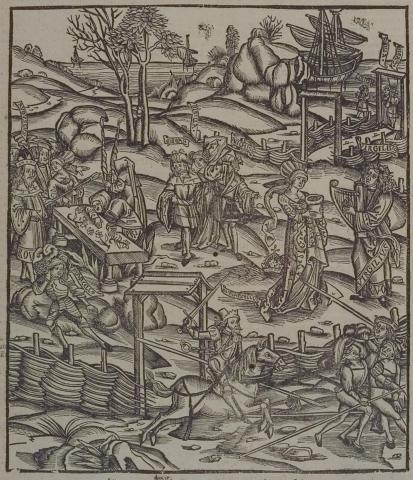In the center, Anchises finishes telling Aeneas and the Sibyl the future of Rome; his face is entirely obscured by the arm of the Sibyl. In the lower right, M. Claudius Marcellus drives away an enemy army, likely the Gauls (855-9; sistet eques, sternet Poenos Gallumque rebellem 858); on his shoulder hangs the spolia opima, the armor, arms, and other effects that an ancient Roman general stripped from the body of an opposing commander slain in single combat. Marcellus was the third and last to do this (tertiaque arma patri suspendet capta Quirino 859).
Young Marcellus (860-6), Augustus's adopted son and heir, is shown on the left, below a funeral scene. In this scene, Augustus stands in regal attire pointing at a funeral bier, which has flowers scattered on it and a fire burning beneath it. A woman weeps at the altar, and other mourners gather behind the tomb (867-86). Servius reports that public mourning for Marcellus was intense, and that Augustus ordered a funeral procession of 600 such biers to enter the city and proceed to the Campus Martius, where Marcellus was interred with great ceremony (huius mortem vehementer civitas doluit: nam et adfabilis fuit et Augusti filius. ad funeris huius honorem Augustus sescentos lectos intra civitatem ire iussit: hoc enim apud maiores gloriosum fuerat et dabatur pro qualitate fortunae; nam Sulla sex milia habuit. igitur cum ingenti pompa adlatus et in campo Martio est sepultus Serv. ad 8.61.)
To the right, Vergil, in the guise of a bard, sings to Marcellus’ mother Octavia, Augustus’ sister, whose importance is signified by a crown next to her. She holds the ashes of her son Marcellus. Servius reports that Vergil wrote this passage as a compliment to Augustus, and that Book 6 was once recited to Augustus and Octavia with such emotion that they, in tears, would have ordered the performance to stop at this point, had not Vergil said that this was in fact the end. (ergo modo in Augusti adulationem quasi epitaphion ei dicit. et constat hunc librum tanta pronuntiatione Augusto et Octaviae esse recitatum, ut fletu nimio imperarent silentium, nisi Vergilius finem esse dixisset. ibid.)
In the top right corner, Anchises leads Aeneas and the Sibyl up from the underworld, out through the gates of Sleep, to the world above. Aeneas's ship waits along the shore by the underworld's exit (893-8).
Woodcut illustration from the “Strasbourg Vergil,” edited by Sebastian Brant: Publii Virgilii Maronis Opera cum quinque vulgatis commentariis expolitissimisque figuris atque imaginibus nuper per Sebastianum Brant superadditis (Strasbourg: Johannis Grieninger, 1502), fol. 286r, executed by an anonymous engraver under the direction of Brant.


Sebastian Brant (1458-1521) was a humanist scholar of many competencies. Trained in classics and law at the University of Basel, Brant later lectured in jurisprudence there and practiced law in his native city of Strasbourg. While his satirical poem Das Narrenschiff won him considerable standing as a writer, his role in the transmission of Virgil to the Renaissance was at least as important. In 1502 he and Strasbourg printer Johannes Grüninger produced a major edition of Virgil’s works, along with Donatus’ Life and the commentaries of Servius, Landino, and Calderini, with more than two hundred woodcut illustrations. (Annabel Patterson)